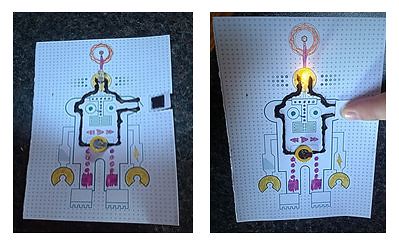
Meet my robot, Nano
Sure enough, the robots were a hit. It took two tries for me to get it right on my own, and I was a bit stressy about getting it to work with the students, but it was nowhere near as aaargh as I thought it was going to be. I prepared the switches on the circuits beforehand, and punched the holes where things needed to be attached to the card - so all that was left to do was decorate, install the battery and LED bulb, and then use the conductive paint to connect them, making a circuit. The group did the lemon battery experiment beforehand, so they'd seen and felt firsthand how a circuit worked, and could explain to me what was in the robot's circuit that was different and why it would work better (stronger power source, and a smaller bulb). We had a small army of robots ready to go home at the end of the session, and I still have heaps of paint left over.

A Nano robot in action
My only criticism is that the paint took longer than the quoted 15 minutes to dry. On a product recommended for six year olds, this is a bit of an issue, in my mind. My group are pretty good at being patient, but when you're six, you don't really have an endless supply of calm when you're waiting for a robot to play with. The best result I got while experimenting was leaving it overnight to dry, and then closing the circuit with the switch to test it out, and I explained that to the group from the beginning, which helped. I also made the recommendation to the parents when they came to pick their children up, so we'll see what the feedback is like when I see them again in a few weeks.
Totes electrifying. Bare Conductive have other cool cards, too, that come in smaller (read: less expensive) kits - I'd definitely recommend checking them out for holiday fun/birthday parties/an add-on to school electronics programs. I'm tempted to purchase a few for myself, too!
